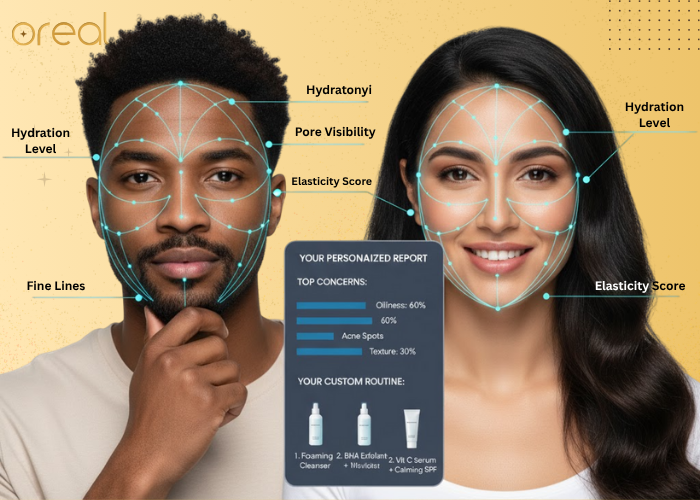
Standing in front of your bathroom mirror, surrounded by half-empty skincare products that promised miracles but delivered disappointment, you might wonder, “Am I using the right products for my skin?” You’re not alone. Millions of people invest in skincare routines based on influencer recommendations, friend suggestions, or attractive packaging—only to discover their skin hasn’t improved or, worse, has developed new problems.
Your skin is as unique as your fingerprint. However, what one person’s skincare regimen derives great results from, you might break out from. This is where skin analysis becomes important; that is why technology like Oréal’s packs is transforming the skincare industry.
Understanding Your Skin’s Unique Needs
Before considering what products to get, you must analyze your skin, not the way marketing campaigns delineate your symptoms to sell products. your skin type, dry, oily, combination or sensitive, is the main starting point, but oreal skin type analysis takes your skin into account as such.
- Hydration levels and moisture retention
- Pore size and visibility
- Fine lines, wrinkles, and elasticity
- Pigmentation and dark spots
- Texture irregularities and roughness
- Sebum production patterns
- Environmental damage indicators
Traditional methods of determining these factors relied on subjective self-assessment or expensive dermatologist visits. Today, AI-powered skin analysis technology makes professional-grade evaluation accessible to everyone.
The Power of Real Skin Analysis Technology
This type of technology is changing the way we understand skin analysis. These modern tools that analyze skin do so very accurately and quickly. They use artificial intelligence to analyze your skin, trained with millions of images of different skin types.
Here’s how real skin analysis technology works:
Step 1: Capture Your Skin Using your smartphone camera or an in-store device, you take photographs of your face in proper lighting. The technology captures high-resolution images that reveal details invisible to the naked eye.
Step 2: AI-Powered Analysis The artificial intelligence examines your skin across multiple parameters, identifying concerns you might not have noticed. It evaluates wrinkle depth, measures pore size, assesses pigmentation uniformity, analyzes skin tone evenness, and detects signs of sun damage or aging.
Step 3: Personalized Insights You receive a comprehensive skin profile detailing your specific concerns, ranked by severity. This objective assessment removes guesswork from your skincare journey.
Step 4: Custom Product Recommendations Based on your unique analysis, the system recommends specific products formulated to address your particular needs—not generic solutions, but targeted treatments for your skin’s reality.
Creating Your Custom Skincare Routine
Armed with real skin analysis data, you can now build an effective routine. Here’s how to structure it:
Morning Routine Foundation
Start with a cleanser that is formulated for your skin type as determined with oreal skin analysis. If your skin is oily, you should use a foaming cleanser that will remove excess as sebum, while for dry skin, a cream cleanser is better to use as it will maintain skin’s hydration.
Follow with a treatment serum addressing your primary concern. If your analysis identified pigmentation issues, vitamin C serums brighten and even tone. For wrinkles and fine lines detected in your scan, retinol or peptide serums stimulate collagen production.
Hydration comes next. Even oily skin needs moisture—your skin analysis will reveal your true hydration levels. Lightweight gel moisturizers work for oily types, while richer creams benefit dry skin.
Never skip SPF. Sun damage accumulates over time, and your oreal skin analysis might already show early signs. Broad-spectrum SPF 30 or higher protects against further damage.
Evening Routine Essentials
Double cleansing will take off makeup, sunscreen, and general daily grime. Use an oil-based cleanser to start with and follow it up with your normal cleanser.
Put on targeted treatments according to what your skin analysis disclosed. This is the time when actives need to be placed. If your analysis showed more than one concern, address them on alternate nights of application so that irritation does not occur.
Night creams or sleeping masks will give deep healing overnight. Choose formulas that support the needs that have been identified in your analysis.
Weekly Treatments
Add exfoliation based on the texture of your skin. Some people use physical exfoliants, while in most cases, chemical exfoliants—whether they be AHAs or BHAs—work better. Let the frequency be guided by your oreal skin analysis—sensitive skin in most cases should be exfoliated once a week, and normal to more resilient skin can take much more.
Masks that target specific concerns found in your analysis further boost your routine. Clay masks for oil control Hydrating masks if there is dryness Brightening masks for pigmentation.
Tracking Progress with Regular Analysis
The beauty of technology-based skin analysis is the ability to track improvement objectively. Modern skin analysis tools allow you to save your initial analysis and compare it with future scans, providing visual proof of your skincare routine’s effectiveness.
Reanalyze your skin every 4-6 weeks. Skin cell turnover takes approximately 28 days, so monthly assessments reveal genuine changes. If your custom routine isn’t delivering results, the updated analysis helps you adjust products or address new concerns emerging.
Beyond Products: Holistic Skin Health
The core of your regimen may be oreal skin analysis and custom products, but don’t forget that great skin goes beyond what’s in your other bottles. Dehydration might be diagnosed in the skin; then serum for hydration is recommended along with increased water consumption. Pre-symptoms of premature aging will be more easily improved with good sleep, stress management, and a proper diet.
Conclusion
Stop guessing what your skin needs. Oreal skin analysis through advanced AI-powered technology removes uncertainty from skincare, replacing trial-and-error with data-driven decisions. Your custom skincare routine should be as unique as you are—built on objective analysis, not marketing hype.
Check out the skin analysis applications and devices of popular cosmetic companies so that you get to know what your skin actually wants. The best products aren’t necessarily the most costly or in highest demand; they’re just the ones recommended by your marketed skin analysis for your specific complexion. Your custom-made skincare voyage starts with knowing your skin’s truth, and this truth is now within everyone’s reach courtesy of technology.






